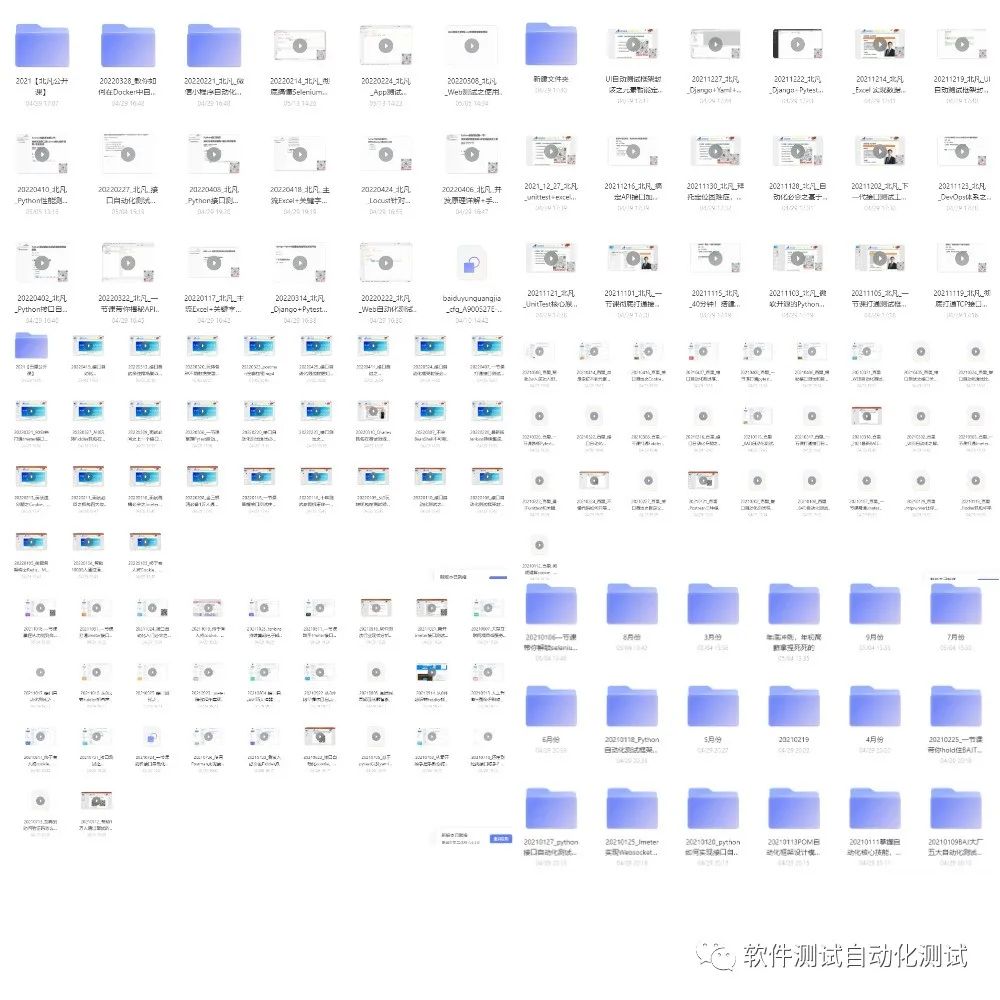-
全网最牛自动化测试框架系列之pytest(11)-Allure生成测试报告
【文章末尾给大家留下了大量的福利哦】
Allure是一个开源的测试报告生成框架,提供了测试报告定制化功能,相较于我们之前使用过pytest-html插件生成的html格式的测试报告,通过Allure生成的报告更加规范、清晰、美观。
pytest框架支持使用Allure生成测试报告,接下来让介绍pytest怎样结合Allure生成测试报告。
环境搭建
安装
allure-pytest步骤
1需要先安装插件allure-pytest,可以理解为用于连接pytest和allure,使它们可以结合使用。安装命令:
pip install allure-pytest安装Allure
根据操作系统在最新版本中选择对应格式的安装文件进行下载,Windows系统选择
allure-2.xx.x.zip下载,如下图所示:
下载后解压文件,并将
bin文件所在的路径加入系统环境变量,再重启电脑,怎样加入环境变量这里不啰嗦,不知道的同学可以百度。至此,环境搭建完成。
定制报告
Allure提供了很多特性用于定制生成测试报告,脚本中加入这些特性可以对测试步骤进行详细的说明,且不会对测试代码逻辑产生影响。
接下来以在线购物平台的
购物车功能模块和下单模块简单举例说明,测试模块test_case.py代码如下:- import allure
- import pytest
- import os
- @allure.step("登录获取token")
- def get_token():
- print("请求登录接口获取token")
- @allure.step("加入购物车")
- def add_to_shopping_trolley():
- print("请求加入购物车接口")
- @allure.step("查询我的购物车")
- def get_shopping_trolley_goods():
- print("请求查询我的购物车接口")
- @allure.step("清空购物车")
- def empty_shopping_trolley():
- print("请求清空购物车接口")
- @allure.step("下单")
- def place_order():
- print("请求下单接口")
- @allure.epic("xx在线购物平台接口测试")
- @allure.feature("购物车功能模块")
- class TestShoppingTrolley:
- @allure.story("商品加入购物车")
- @allure.title("正向用例--将库存数>0的商品加入购物车")
- @allure.description("校验库存数不为0的商品加入购物车是否正常")
- @allure.severity("critical")
- def test_add_goods(self):
- get_token()
- add_to_shopping_trolley()
- @allure.story("商品加入购物车")
- @allure.title("异常用例--将库存数=0的商品加入购物车")
- @allure.description("校验库存数为0的商品加入购物车是否提示正确的错误信息")
- @allure.severity("normal")
- def test_add_goods_error(self):
- get_token()
- add_to_shopping_trolley()
- @allure.story("查询购物车商品数量")
- @allure.title("查询购物车所有商品的总数量")
- @allure.description("校验查询购物车所有商品的总数量是否正常")
- @allure.severity("critical")
- def test_get_goods_quantity(self):
- get_token()
- add_to_shopping_trolley()
- get_shopping_trolley_goods()
- @allure.story("查询购物车商品数量")
- @allure.title("查询购物车单个商品的数量")
- @allure.description("校验查询购物车单个商品的数量是否正常")
- @allure.severity("critical")
- def test_get_goods_quantity(self):
- get_token()
- add_to_shopping_trolley()
- get_shopping_trolley_goods()
- @allure.story("清空购物车")
- @allure.title("加入商品后再清空购物车")
- @allure.description("校验清空购物车接口功能是否正常")
- @allure.severity("normal")
- def test_empty_shopping_trolley(self):
- get_token()
- add_to_shopping_trolley()
- empty_shopping_trolley()
- @allure.epic("xx在线购物平台接口测试")
- @allure.feature("下单模块")
- class TestPlaceOrder:
- @allure.story("购物车下单")
- @allure.title("商品加入购物车再下单")
- @allure.description("校验清购物车下单功能是否正常")
- @allure.severity("critical")
- def test_place_order(self):
- get_token()
- add_to_shopping_trolley()
- place_order()
- @allure.story("立即购买下单")
- @allure.title("选择商品不加入购物车立即购买下单")
- @allure.description("校验立即购买下单功能是否正常")
- @allure.severity("critical")
- def test_order(self):
- get_token()
- place_order()
上面测试代码中使用了Allure的一些特性,为了更好的理解这些特性的使用,我们可以将测试脚本由上至下进行分层:
- 被测系统,即被测系统的描述,如在线购物商城
- 功能模块,一个被测软件系统包含一个或多个功能模块,如在线购物商城包含登录、购物车、下单、支付、发货等模块
- 使用场景,一个功能模块中包含一个或多个用户使用场景,如购物车模块包含加入购物车、修改数量、清空购物车的场景
- 测试用例,一个场景包含一条或多条测试用例,如加入购物车包含库存数>0 或 <0等测试用例
- 测试步骤,一条测试用例由一个或多个测试步骤构成,如将库存数>0商品加入购物车,测试步骤为:登录-->商品加入购物车
对照以上分层,我们再来理解代码中使用的这些Allure特性,如下:
-
@allure.epic(),用于描述被测软件系统 -
@allure.feature(),用于描述被测软件的某个功能模块 -
@allure.story(),用于描述功能模块下的功能点或功能场景,也即测试需求 -
@allure.title(),用于定义测试用例标题 -
@allure.description(),用于测试用例的说明描述 -
@allure.severity(),标记测试用例级别,由高到低分为 blocker、critical、normal、minor、trivial 五级 -
@pytest.allure.step(),标记通用函数使之成为测试步骤,测试方法/测试函数中调用此通用函数的地方会向报告中输出步骤描述
生成报告
生成Allure报告步骤
pytest中Allure生成测试报告需要经过如下两步操作:
-
首先,生成测试结果数据:
- # python代码执行
- pytest.main(['testcase/test_case.py', '-s', '-q', '--alluredir', './result'])
- # 命令行形式
- pytest testcase/test_case.py --alluredir ./result
即运行
testcase/目录下的测试用例,将测试结果以json文件的形式保存至当前目录下的result文件夹中。参数
--alluredir用于指定测试结果保存路径。 -
然后,生成HTML格式的测试报告:
- # python代码执行
- os.system('allure generate ./result -o ./report --clean')
- # 命令行形式
- allure generate ./result -o ./report --clean
即将当前目录下的
result文件夹中的json数据,生成测试报告结果及index.html,并保存至当前目录下的report文件夹中。--clean表示先清除之前的测试报告,使用与否视情况自行选择。
执行代码
因此,执行模块
run.py代码编写如下:run.py:- if __name__ == '__main__':
- pytest.main(['testcase/test_case.py', '-s', '-q', '--alluredir', './result'])
- os.system('allure generate ./result -o ./report --clean')
运行
run.py,结果如下:
报告结果展示
运行
run.py后,在run.py同级目录下新增了result文件夹,以及文件夹下的json文件,有多少条测试用例就生成多少个名称为xxxx-result.json的结果文件。同样在
run.py同级目录下新增了report文件夹,report文件夹中生成了一些文件,包括index.html,如下:
在浏览器中打开
index.html,打开后首页如下:
选择点击
Behaviors后,结果如下:
Allure报告默认语言为英文,可以选择中文,如下:

总结
可以把epic、feature、story理解为将测试用例按照功能模块进行分类,epic为一级类目,feature为二级类目,story为三级类目。
而title、description、severity、step等则用于测试用例自身相关的描述定义。
当然,Allure还有其他的常用特性,下篇文章我们再继续学习。
重点:学习资料学习当然离不开资料,这里当然也给你们准备了600G的学习资料
【需要的可以扫描文章末尾的qq群二维码自助拿走】
【记得(备注“csdn000”)】
【或私信000】
群里的免费资料都是笔者十多年测试生涯的精华。还有同行大神一起交流技术哦。
项目实战:

大型电商平台:

全套软件测试自动化测试教学视频

300G教程资料下载【视频教程+PPT+项目源码】

全套软件测试自动化测试大厂面经

python自动化测试++全套模板+性能测试


听说关注我并三连的铁汁都已经升职加薪暴富了哦!!!!
-
相关阅读:
直流无刷电机FOC控制算法 理论到实践 —— 实践
深入URP之Shader篇4: Depth Only Pass
2022杭电多校十 1004-Average Replacement(猜结论+并查集)
7.6、bean的周期10步源码解析
Sql查询所有子级元素
亘古难题——前端开发or后端开发
MySQL表数据导入导出
探讨Acrel-1000DP分布式光伏系统的设计与应用-安科瑞 蒋静
如何解决小程序异步请求问题
ALGO开发源码【node服务】
- 原文地址:https://blog.csdn.net/m0_60054525/article/details/126711787
